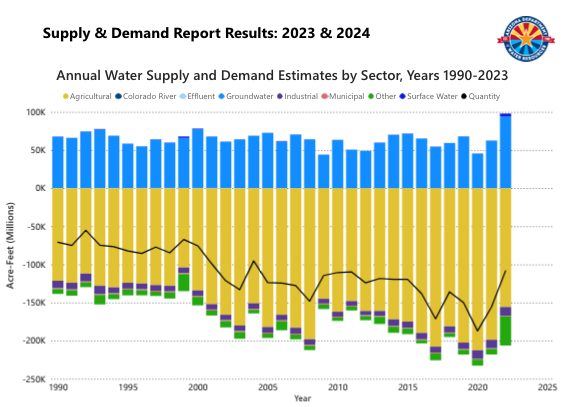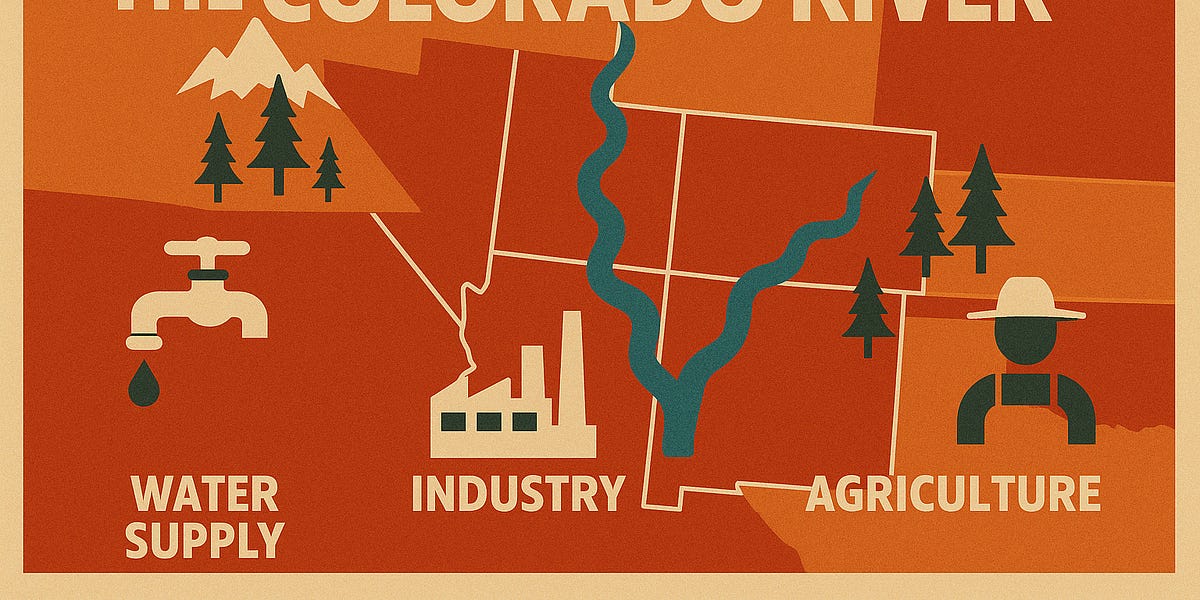- Ground Party Papers
- Posts
- A proclamation, a proposal, and a precaution
A proclamation, a proposal, and a precaution
Fourth Sunday of April, 2025
In this issue…
Builder News
A proclamation
Water News
Proposed goal for Willcox AMA
Governor Hobbs vs Gail Griffin
“Forever plastics” in the water and soil
Land News
Regulations on logging and emissions
County Supervisors to discuss grey wolves
Be careful out there!

Howdy from the editor
It’s cooled off a bit today in Cochise County, but there’s a Red Flag warning for wildfires due to high wind speeds and low humidity.
One thing that I appreciate about Cochise County government is their tight financial budget. I’ve looked at the books and there is very little fat — because they know how much residents don’t like paying more in taxes. In fact, they just received received the national “Distinguished Budget Presentation Award” for good financial planning and public communication. Good job, Cochise County.
In Douglas, Mayor Jose Grijalva just led the city council to suspend its current “amusement tax,” a 3.8% tax affects vendors at the Cochise County fair, gyms, event venues and other businesses. “Putting it on hold will really help us, because a lot of businesses are gradually building back up,” said Arturo Torres who owns the Balar event space in Douglas.

12 months of new subscribers to the Ground Party Papers
And the Ground Party Papers will be holding a Year 1 Birthday Party next month on May 26. There will be refreshments, mezcal, coffee, and my famous homemade “4-dimensional salsa.” Music too! More details coming. Save the date.

Tomorrow I’ll be submitting the following draft memorandum to Cochise County Deputy Manager Joe Casey for the establishment of June 6 as Cochise County Owner-Builder Day. I’ll submit a similar draft memo for October as Cochise County Opt-Out Month.
PROCLAMATION
COCHISE COUNTY OWNER-BUILDER DAY
WHEREAS, On June 6, 2006, the Cochise County Board of Supervisors adopted the Owner-Builder Opt-Out Amendment, establishing a pathway for rural residents to construct owner-built homes without complying with county building codes; and WHEREAS, The amendment was designed to preserve the rural character of Cochise County, encourage innovation in housing, and promote individual self-reliance and land stewardship; and WHEREAS, The amendment has enabled thousands of residents to build safe, energy efficient homes using locally sourced materials and natural building techniques that reflect local needs and values; and WHEREAS, In a time of rising housing costs and economic uncertainty, the amendment continues to provide families with a unique and empowering means of attaining homeownership and long-term stability; and WHEREAS, The continued relevance of this policy underscores Cochise County’s leadership in crafting locally-driven solutions that honor both freedom and responsibility in rural development; and WHEREAS, June 6 marks the anniversary of the amendment’s adoption and provides an opportunity for education, celebration, and renewed commitment to rural self-determination; NOW, THEREFORE, BE IT RESOLVED that the Cochise County Board of Supervisors hereby proclaims June 6 of each year to be: “COCHISE COUNTY OWNER-BUILDER DAY” and urges all members of our community to support, preserve, and promote rural pathways to homeownership and creative, sustainable housing solutions in Cochise County.

Halfway to sustainability
The Arizona Department of Water Resources has proposed that the goal of the Willcox AMA should be to reduce the area’s groundwater overdraft by at least 50% over the next 50 years. The Willcox Basin is currently overdrafting its aquifer at a roughly 3:1 rate. The 50% reduction, if achieved, would mean the basin is only using twice as much water as it can sustainably afford to. Some say the goal is too lofty, while others say it's literally a half-solution at best.
“To support the long-term viability of the regional economy, mitigate land subsidence, and extend the life of the aquifer by reducing groundwater overdraft by at least 50 percent by 2075.”
ADWR's proposed Willcox AMA goal
Willcox AMA water supply (top) and demand (bottom) | ADWR
Hobbs vs Griffin
Our local district Representative Gail Griffin passed a number of groundwater-related bills through the legislature this year. In one of them, she even included a clause I had asked her for, allowing small farmers in AMAs to have a longer qualifying timeline for grandfathering their acres into an AMA. Unfortunately, I had asked for that two years ago, and now its too late. And she tacked it onto a very bad water bill that I’m glad didn’t pass.
In any case, Griffin is very upset with Governor Hobbs for not signing any of her bills into law. She recently wrote in press releases:
“In rural Arizona, shallow domestic wells, typically between 100 and 300 feet deep, are going dry. … Some residents, in desperation, have turned to lobbying the government to pass laws that would force other water users to cut back, believing that groundwater levels might increase if other users used less. … Just because a person drills a well does not guarantee the person will get water. … Overall, water hauling is a popular and acceptable way to receive water, allowing residents to maintain a rural lifestyle…”
Griffin thinks groundwater regulations aren’t the answer and, instead, we should create a water district that allows people to haul water. The local Riverview megadairy is onboard with that plan and wants to help create the water hauling system.
But Hobbs says she would prefer to create laws that will make sure groundwater pumping eventually gets reduced to sustainable levels in order to stabilize groundwater levels.
“Each of these bills has a connection with groundwater policy in rural Arizona. Yet again, I am disappointed that none of these bills would make a difference in solving the water policy challenges that Arizona residents and communities are facing today. I said in my State of the State. bills that are just political cover for the Legislature’s inaction on water security will meet my veto pen.”
Plastic in the groundwater and animals
Be careful about which fertilizers you buy. Helen Kerwin, a Republican U.S. Representative from Texas recently proposed a new federal law to limit the amount of PFAS (forever chemicals) in fertilizers. This was in response to local farmers suing a fertilizer company, alleging that PFAS-contaminated fertilizer made from municipal waste poisoned their land, killed their livestock and left them unable to sell anything produced on their farms.
"Farmers have been horribly taken advantage of,” said the local investigator Dana Ames. “I'm very proud that our legislators heard our cries for help, saw the problem, understood the issue and the magnitude of what we were dealing with, and stepped up.”
But Representative Kerwin’s daughter, Brooke Rollins, who was just appointed as director of the USDA, seems to have a different attitude about PFAS. She’s just banned the following from topics, among others, from all USDA research projects:
“PFAS”
“microplastics”
“water pollution”
“groundwater pollution”
“contaminants of environmental concern”
“water quality”
“clean water”
“safe drinking water”
and even “water efficiency”
As reported previously, Director Rollins has cancelled funding for local farmers to supply food to local schools and food banks, which includes some our own local organic farms like Arevalos Farms.
And this month, the EPA has been ordered to cancel and retire research grants addressing PFAS in food supplies, health problems in rural children who have been exposed to pesticides and other pollutants, as well as the “P3” program which funds colleges to work on environmental problems.
But the U.S. National Science Foundation recently made a major breakthrough on technology that can remove 90% of PFAS (forever chemicals) from groundwater. Hopefully that technology can assist communities in need.
Across the country, towns are finding toxic PFAS in their water supplies at or above allowable levels. In Salisbury, Maryland, the state found PFAS in the wastewater at the local Perdue AgriBusiness factory at levels ten times greater than the EPA allowed standards. But officials waited over a year to tell residents, long after the contamination had started migrating toward residential areas.
The Water Agenda
If you want to catch up with state-wide news, I’ve recently published the following articles:

To regulate or not to regulate
Across the high, broken spine of Arizona’s Sky Islands, a new federal order could open the forests to a chorus of chainsaws and the grumbling of trucks. The plan directs agencies to fast-track commercial logging across millions of acres, including parts of the Coronado National Forest, by cutting environmental protections and public oversight. The NFS released a map of targeted areas which clearly include our local mountain ranges, and that has local groups worried.

NFS’s new logging map
But a former NFS assessment states: "Lands (in the Coronados) having potential commercial–grade timber are located at very high elevations of mountain ranges on four ranger districts. These areas are isolated and difficult to access, making it extremely unlikely for a single processing facility to develop a feasible business model that could incorporate most timbered lands.”.
“We’ve been seeing this kind of contradictory, confusing things happening with the administration,” said Louise Misztal, director of the Tucson–based Sky Island Alliance.
The Apache Generating Station on Highway 181 has secured a federal waiver allowing it to follow older, looser pollution standards instead of new EPA rules issued in 2024. Though Arizona Electric Power Cooperative says the plant will still protect public health, environmental groups warn that rolling back mercury, lead, and arsenic limits could worsen air quality and endanger nearby communities. President Trump’s executive order promoting coal and cutting EPA oversight enabled the waiver, part of a broader push to revive coal even though Arizona utilities — including Apache — plan to phase it out by 2032.
An Arizona bill that would have allowed the construction of small modular nuclear reactors in rural Arizona without environmental or zoning approvals was vetoed last week by Gov. Katie Hobbs. In her veto letter, Hobbs said she supports exploring new technologies but criticized the measure for offering broad exemptions for a type of reactor not yet commercially operational in the U.S. Bill sponsor Rep. Michael Carbone, Buckeye, called the veto "misguided" and said he plans to revive the idea in future sessions, arguing that rural economies and future energy needs — especially for AI-driven industries — depend on early planning for more power.
Wolf country
There are 286 lean-legged shadows running the Mogollon Rim, 124 of them in Arizona’s high country alone. On May 8, 10 a.m., Cochise County Supervisors will hold a work session to discuss the population of Mexican wolves in our area of the Sky Islands, which local ranchers say are responsible for some cattle deaths. Pascal Berlioux, Director of the Eastern Arizona Counties Organization, will outline federal recovery plans, legal issues, management actions, and will field questions from the Supervisors. “Work session” means no public testimony will be taken, but residents can attend in person, by phone, or via Microsoft Teams — more info here.
On April 14, a federal removal order targeting one uncollared Mexican gray wolf in Arizona’s Apache National Forest instead resulted in the killing of Asiza, a collared and protected wolf belonging to the Bear Canyon seven-wolf pack. The federal order said to not kill Asiza because she was the pack’s only breeding female “who will likely whelp a new litter of pups soon.” Environmental advocates are demanding a full investigation.
Careful out there
The Cochise County Sheriff’s office is looking for a missing hiker, 27-year-old Erick Consuega, who was last heard from on April 5. He’s 5ft-6 and 160 pounds. Anyone with information can contact the Sheriff’s office at 520-803-3550

Erick Consuega
And I see on my local news feeds reports of wild animals testing positive for rabies all the time. Mostly skunks, sometimes foxes, even a bobcat recently. I used to have a skunk friend living under my house — never sprayed the place, cute little guy. But do be careful, especially with the kids!
If you enjoyed this newsletter, forward it to a friend.
And…
Thanks for reading!


Reply